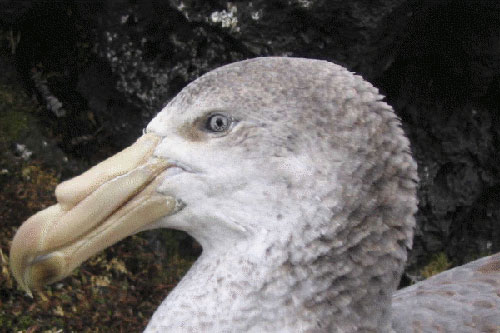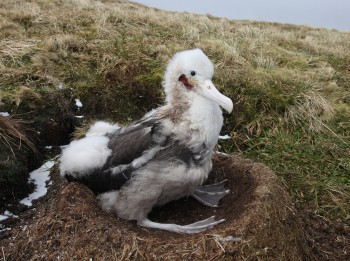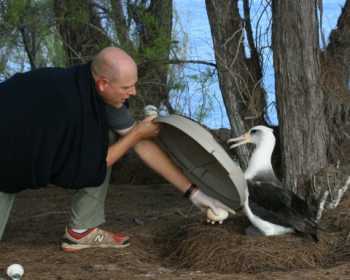Northern Giant Petrels Macronectes halli are one of the earliest breeding species on Bird Island, South Georgia (Islas Georgias del Sur)* with first eggs laid between 13 and 18 September 2014 in a study area which contains approximately 300 nests. Around 60 pairs of Brown or Subantarctic Skuas Catharacta antarctica also nest in the area, being absent for the coldest months of winter, and returning in early to mid-September. At this time the ground is often frozen and snow-covered; Gentoo Pygoscelis papua and Macaroni Eudyptes chrysolophus Penguins have yet to lay and Antarctic Fur Seals Arctocephalus gazella have not yet given birth, so there is very little terrestrial food available for skuas.

Northern Giant Petrel, photograph by Marienne de Villiers
In recent years skuas have been seen harassing giant petrels and this spring two instances of egg theft have been caught on camera.
In the first video clip (from 23 September 2014) a pair of skuas is seen working together. The first skua drops in behind a male giant petrel sitting tight on its egg, and tugs at its tail feathers before calling to the second bird. As the second skua appears in front of the petrel the first skua resumes tugging on the tail. In an effort to reach its assailant the petrel stands and twists a little, giving just enough time for the second skua to snatch the egg out from under it and fly away.
The second clip (from 24 September 2014) shows a single skua jumping from side to side, tugging at a female giant petrel’s tail and wings, encouraging it to stand and climb off the nest. This is complicated by the presence of a second giant petrel (not the partner of the incubating bird), but when he leaves the skua is able to steal the egg after dragging her away by her outstretched wing.
Although failure during incubation is not uncommon in giant petrels and albatrosses breeding on Bird Island, until this footage was recorded it was generally assumed that egg predation by skuas only occurred after the incubating adult had deserted the nest and left its egg unattended. Despite thousands of visits to colonies over the years, active egg theft by skuas has never been seen before, which suggests it was, and perhaps still is, an unusual behaviour. An adult giant petrel is a formidable predator, twice the mass of a Brown Skua, so trying to steal its egg carries an element of risk. It is unknown whether this egg-stealing behaviour is a new feeding method, or, given the skill required, has always been used but only by a small number of specialised individuals.
With thanks to Andy Wood for assistance.
Jerry Gilham, British Antarctic Survey, Cambridge, UK, 15 October 2014
*A dispute exists between the Governments of Argentina and the United Kingdom of Great Britain and Northern Ireland concerning sovereignty over the Falkland Islands (Islas Malvinas), South Georgia and the South Sandwich Islands (Islas Georgias del Sur y Islas Sandwich del Sur) and the surrounding maritime areas.

 English
English  Français
Français  Español
Español 



